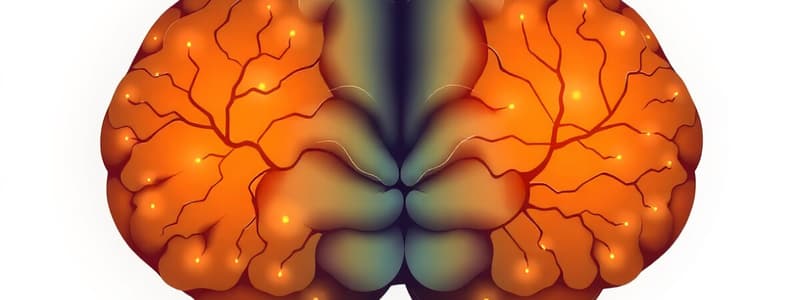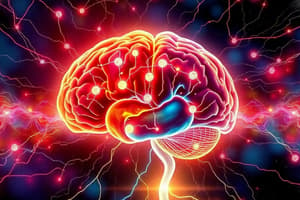Podcast
Questions and Answers
Which brain area is primarily involved in the preoccupation/anticipation stage of addiction?
Which brain area is primarily involved in the preoccupation/anticipation stage of addiction?
- Basal Ganglia
- Prefrontal Cortex (correct)
- Limbic System
- Hippocampus
In the binge/intoxication stage of addiction, dopamine is released mainly due to cues rather than the drug itself.
In the binge/intoxication stage of addiction, dopamine is released mainly due to cues rather than the drug itself.
True (A)
What is the 'anti-reward' mechanism in the withdrawal stage of addiction?
What is the 'anti-reward' mechanism in the withdrawal stage of addiction?
The activation of brain stress systems and the amygdala leading to increased negative mood.
The ____ system is critical in the regulation of stress response during addiction.
The ____ system is critical in the regulation of stress response during addiction.
Match the stages of addiction with their corresponding brain areas:
Match the stages of addiction with their corresponding brain areas:
Match the following antidepressants with their primary use or characteristics:
Match the following antidepressants with their primary use or characteristics:
Match the following opioids with their characteristics:
Match the following opioids with their characteristics:
Match the sleep aids with their mechanisms:
Match the sleep aids with their mechanisms:
Match the following psychedelics with their primary effects:
Match the following psychedelics with their primary effects:
Match the following substances related to cannabis with their roles:
Match the following substances related to cannabis with their roles:
Match the following treatments for alcohol use disorder:
Match the following treatments for alcohol use disorder:
Match the following addiction-related components with their interventions:
Match the following addiction-related components with their interventions:
Match the following medications to their effects on pain management:
Match the following medications to their effects on pain management:
Flashcards
Binge/Intoxication Stage
Binge/Intoxication Stage
The initial stage of addiction where drug use causes dopamine release in the reward pathway. Drug-cue associations form, leading to habit formation and cue-driven dopamine release.
Withdrawal/Negative Affect Stage
Withdrawal/Negative Affect Stage
A stage of addiction where the brain's reward pathway desensitizes, and stress and negative mood increase due to activated brain stress systems.
Preoccupation/Anticipation Stage
Preoccupation/Anticipation Stage
In this stage, the brain's executive functions, like decision-making, weaken. The prefrontal cortex is more reactive to drug cues while less responsive to natural rewards.
Reward Pathway
Reward Pathway
Signup and view all the flashcards
Incentive Salience
Incentive Salience
Signup and view all the flashcards
Duloxetine
Duloxetine
Signup and view all the flashcards
Selegiline
Selegiline
Signup and view all the flashcards
Venlafaxine
Venlafaxine
Signup and view all the flashcards
Morphine
Morphine
Signup and view all the flashcards
Naloxone
Naloxone
Signup and view all the flashcards
Buprenorphine
Buprenorphine
Signup and view all the flashcards
Tramadol
Tramadol
Signup and view all the flashcards
Ramelton
Ramelton
Signup and view all the flashcards
Study Notes
Stages of Addiction and Underlying Circuitry
- Binge/Intoxication Stage:
- Reward Pathway: The basal ganglia (striatum) are activated. Initial drug exposure releases dopamine.
- Incentive Salience: Drug use forms associations between drugs and cues predicting their availability, leading to habit formation in the basal ganglia. Dopamine is later released in response to these cues, not the drug itself.
- Withdrawal/Negative Affect Stage:
- Limbic System (Amygdala): Activation of the amygdala underlies negative mood.
- Stress System (HPA Axis): The stress system is activated, increasing negative feelings. The reward pathway becomes less responsive to normal rewards.
- Preoccupation/Anticipation Stage:
- Prefrontal Cortex (PFC): Impaired decision-making, driven by hypofrontality linked to drug use, leading to desensitization of PFC to natural rewards but increased sensitivity to drug cues.
- Insula: The insula is highly sensitive to cravings (interoception).
- Basal Ganglia: The basal ganglia's "autopilot" for habits remains active.
- Stress System (HPA Axis): The stress response remains elevated.
- Reward Deficiency?
- Fewer D2 receptors potentially link to increased pleasure from stimulants.
Studying That Suits You
Use AI to generate personalized quizzes and flashcards to suit your learning preferences.




